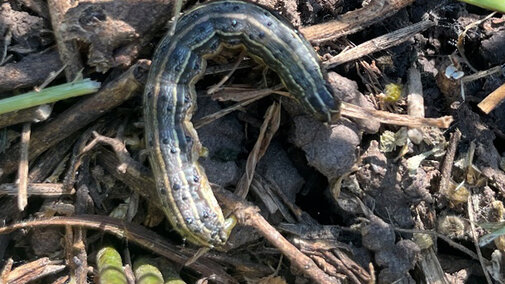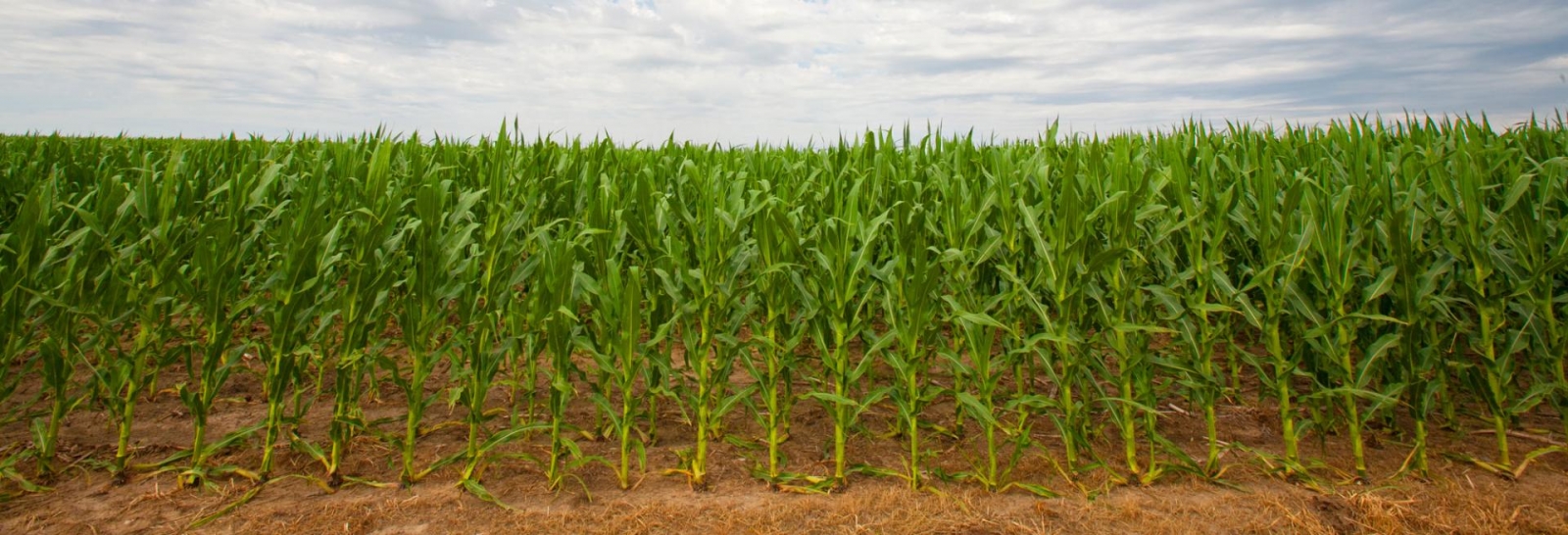With fall armyworms at unprecedented levels in Nebraska this season, many growers have questions about how to manage this pest. Fall armyworm (Spodoptera frugiperda) is a migratory pest that does not overwinter in our region; moths move north from the southern U.S. each summer and can build quickly in late summer and early fall. In alfalfa, forage, and hay systems, risk is highest in new seedings and tender post-cut regrowth, and infestations often expand from field edges or adjacent small grains and pastures.
The following Q&A addresses the specific questions we’ve received.

Q: I’m seeing browning in my crop, pasture, or lawn situation that happened within the past few days, but I don’t see any insects. Could this be fall armyworm?
A: Yes — rapid browning over just a few days with no insects on the plants is an expected fall armyworm (FAW) scenario. Larvae feed mostly near dusk, night and dawn, hiding in the low canopy, or at the soil line during the day. Here’s how to confirm (and avoid false alarms). Check at first light or near sunset. Part the canopy and inspect the soil surface, crowns and thatch. Focus on the transition zone where brown areas meet green growth; FAW often advances using visual cues. In pastures/hay, scout field edges, waterways, irrigated spots and along adjacent crops/turf (common starting points).
When scouting, it helps to shake plants over a white tray or paper to dislodge small larvae. In forage/alfalfa, use a sweep net and take sweeps in both damaged and green areas ahead of the damaged wave. The University of California recommends for turf/lawn to do a simple soap-flush test (1 to 2 tablespoons of dish soap in 1 gal water, poured over ~1 sq yd.). Larvae surface within a few minutes if present and will facilitate accurate larval counts.
Q: What is the threshold for fall armyworm?
A: A reasonable treatment threshold is finding three or more caterpillars per square foot within a field, pasture or lawn. When considering a chemical treatment option, keep in mind caterpillars ¾-inch or longer are close to maturity and can be harder to control with an insecticide.
In alfalfa (by stand stage):
- New seedings: 1–2 larvae/ft² can destroy seedlings; treat or consider an early cutting if close to harvest.
- Established (≈12–14 in.) stands: 10–15 larvae/ft² can defoliate rapidly; intervene before most larvae exceed ¾ inch.
Pastures/hayfields (cool-season grasses, mixed forages): Use a working threshold of ≥3 larvae/ft², adjusting lower if you’ve got tender regrowth or newly established fields. Border/edge infestations can justify spot or border sprays if a “front” is moving in.
Lawns/turf (for comparison): The generic action threshold is 2–3 larvae/ft²; a quick soapy-water flush can help confirm presence before treating.
Q: My new seeding of alfalfa looked amazing and now it’s essentially gone. What should I do?
A: We’ve heard a number of these reports and it’s hard to see this happen. If the armyworms are still present and feeding, there are several control options: active ingredients including the pyrethroids, Alpha-cypermethrin, Beta-cyfluthrin, cyfluthrin, Gamma-cyhalothrin, Lambda-cyhalothrin, permethrin and Zeta-cypermethrin, organophosphates, chlorpyrifos, and carbamates, carbaryl and methomyl.
Organic/softer options (best on small larvae): Spinosad (e.g., Entrust SC), Bt products, azadirachtin (Neemix), and Beauveria bassiana can suppress small larvae but act slowly and require good coverage and favorable conditions for optimal control. They also are less likely to impact beneficial insects.
Chlorpyrifos note: Federal tolerance and label status have been in flux. EPA reinstated tolerances in December 2023 after a court ruling and has proposed limiting most food uses to 11 crops (including alfalfa). States may impose additional restrictions. Always verify current labels and state guidance before considering use.
It's important to watch regrowth — if you still have live crowns and can suppress small larvae quickly, many seedlings will rebound. If reseeding is necessary, it may be wise to wait for reseeding until the spring with it being so late in the season.
Q: My established alfalfa stand is now sticks due to fall armyworms. I plan to get it cut off now, but should I also treat it?
A: We’ve heard several reports where the alfalfa was cut but the armyworms survived and are feeding on regrowth. Scouting is important to prevent this from happening in the future. Fall armyworm migrates in late summer and outbreaks can strip seedlings within a few days. Scouting is best done in late July, August and September.
Cutting a “stick” stand is appropriate as long as it’s not too late in the season (late September) that plants cannot winterize properly. Cutting a stick stand won’t remove the pest pressure by itself. Protect the next seven to 10 days of regrowth — that’s where your yield and stand vigor are made or lost. Re-scout promptly; if live larvae are still present, treat to save the regrowth with products listed in the previous question if necessary.
Q: In the past few days, I’ve gotten brown patches in my pasture. I’ve found armyworms and I currently have cattle grazing. Is there a product I can use that will save my pasture and not hurt my cattle?
A: Warrior II, Mustang Max, Beseige, Prevathon have 0-day grazing restrictions. You can see additional active ingredients, grazing, and haying restrictions at this website from Auburn Extension.
Q: I plan to plant wheat, rye, triticale for grain or a cover crop this fall. Should I seed now or wait to seed?
A: We’d recommend waiting to seed wheat until after the Hessian fly-free date for your area. With the cooler weather, our hope is the armyworms will begin moving south. We unfortunately don’t know for sure when this will happen. One could wait until early October to seed small grains for grain or cover crop if you’d like to take a wait-and-see approach for the armyworms.
If you’d prefer seeding sooner, be sure to scout newly emerging plants. Insecticide options include products with active ingredients including pyrethroids, alpha-cypermethrin, beta-cyfluthrin, cyfluthrin, gamma-cyhalothrin, lambda-cyhalothrin, permethrin and zeta cypermethrin, organophosphates, chlorpyrifos and carbamates, carbaryl and methomyl.
Organic options include products with Bt.
Q: My cover crop was obliterated due to armyworms. What can I treat it with and should I reseed?
A: This is the harder question to answer as cover crops aren’t listed on many insecticide labels. One approach is to look at a product you’re considering and see if any of the species in the mix — such as small grains — are listed on it. Also look for any grazing restrictions if you plan to graze the cover crop.
Regarding reseeding, at this point in the season, we wouldn’t recommend anything other than small grains, such as rye, wheat, triticale or barley, for seeding due to the length of time the cover has before establishment and fall frost.
Q: My fescue lawn has rapidly turned brown and I’m finding armyworm in it. What can I use to treat it?
A: There are a number of products available in lawn/garden/farm and box stores. Read the label to see if fall armyworms are listed for control. Sevin is a commonly used product that is becoming harder to find in towns where fall armyworms are more severe. Organic options include products with Bt such as Dipel.
Products should be watered into lawns to move the granules off the leaf surface down to the soil. Fescue lawns may need to be reseeded in the impacted patches. In lawns that are solely bluegrass or a bluegrass/fescue mix, the bluegrass should spread to help cover the impacted areas, so reseeding may not be necessary depending on the severity.
References
- UNL CropWatch. “Fall Armyworms Damaging Alfalfa in Southeast Nebraska” Aug. 24, 2021. (link)
- UNL CropWatch. “Fall Armyworms in Pastures, Alfalfa, Small Grains, Cover Crops, and Lawns” Sept. 24, 2021. (link)
- Kansas State University Agronomy eUpdate. “Fall armyworm season approaches – Get ready to scout fields” Issue 1058, June 20, 2025. (link)
- Kansas State University Agronomy eUpdate. “Update on fall armyworms in Kansas” Issue 1019, Sept. 5, 2024. (link)
- Kansas State University Agronomy eUpdate. “Late-summer insect update: Fall armyworms” Issue 1065, Aug. 7, 2025. (link)
- Iowa State University Integrated Crop Management (ICM) Blog. “Fall armyworms making an appearance in 2024” Aug. 20, 2024. (link)
- Iowa State University ICM Blog. “Fall Armyworm Management Considerations in Alfalfa and Cover Crops” Sept. 17, 2021. (link)
- Iowa State University ICM Blog. “Fall Armyworms: Round 2” Sept. 25, 2024. (link)
- Iowa State University ICM News. “Fall armyworm is a 2021 Late-Season Pest” Sept. 2021. (link)
- UNL CropWatch. “Evaluating Alfalfa Stands Part 1 — Using the Hay Square Method” Sept. 2020. (link)
- Iowa State University ICM News. “Check Alfalfa Stands for Winter Injury” April 2022. (link)
- Nebraska Extension. “2025 Guide for Weed, Disease, and Insect Management in Nebraska (EC130)” 2025. (link)
- U.S. EPA. “EPA Announces Next Steps to Protect Endangered Species from Chlorpyrifos” (includes Dec. 28, 2023 tolerance reinstatement and forthcoming proposed rule), 2024. (link)
- Federal Register. “Chlorpyrifos; Tolerance Revocation (Proposed Rule)” Dec. 10, 2024; comment period reopened Feb. 20, 2025. (link)

